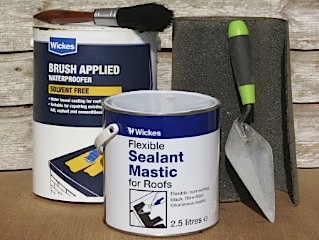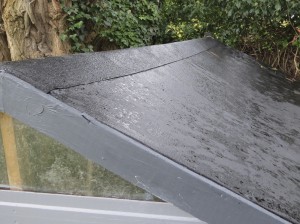How to fix a shed roof
How to fix a shed roof is a topic that can certainly range in extremes, from simply tacking back down some loose felt, to discovering the ply or building boards (roof sheets) used to make up the structure of the roof are totally rotten, and so complete replacement becomes necessary. Below are a few considerations and solutions to common shed roof problems, as well as what I’ve found to be a selection of excellent products for fixing a shed roof.
Shed roof replacement
Starting at the extreme end of things, if your roof felt is completely degraded, and leaks have been left untended, then you will have to have the whole lot off and start again. Basically, if the roof sheets are rotting, you’re going to have to bite the bullet, clear everything out of the shed, take the roof off, felt and all. Most shed roofs are simple secured along the gable edges, and roof apex, and the sheets can be easily prised up at the edges using a claw hammer. Clear the debris, get yourself some exterior grade ply, felt and galvanised nails, and off you go. Designs always vary but the principles of fitting a shed roof can be seen in my guide – ‘Building a shed’.
Replacing shed roof felt
Replacing roof felt when the old stuff has started to deteriorate is theoretically a straightforward option. However, the main problem with this solution is that because of the increasingly flimsy construction of modern flat-packed sheds, doing any sort of work on them that requires a hammer to prise out old nails, and start banging new ones into a roof sheet that itself may have started to sag and deteriorate, can often end up with breaking the roof sheet, and suddenly you’re into whole roof replacement territory. If your shed has a tongue and groove roof or the roof sheet is made of thicker board than the really thin, mdf-type green stuff you see around nowadays, then roof felt replacement is still a good option. However, if you’ve got the thin wispy stuff, then I really would try to avoid too much banging around with a hammer.
Roof repair materials

Three products I find incredibly useful for shed repair – capping sheet, waterproofer, and flexible mastic.
Therefore, my recommendation is that for a large number of repairs, a combination of repair materials, not involving a hammer, and instead using scrapers, trowels and paint brushes, are very effective options to consider. The key to success using the products shown here is to get in early before roof damage has really taken a grip.
The three products shown to the right are Wickes own brand products, although there will of course be equivalents from other manufacturers.
1. Waterproofer
Waterproof ‘paint-on’ coatings are an excellent way of repairing roofing felt that is showing minor damage, or simply starting to age. You simply brush it on, or use a cheap roller. It’s thick enough to fill any tiny holes, whilst being thin enough to apply like a standard paint. Fast, simple and effective.
2. Roof sealant mastic

A shed roof, one year on from all three of these products being used – watertight and weatherproof!
Roof sealant mastic is a bituminous product that you trowel on to repair cracks and tears in the felt, but I find it particularly useful in combination with fitting a new roof capping sheet (see below). For example where the roof felt has cracked or is showing deterioration along the apex of the roof, if you remove just that section of the felt, you can apply a section of capping sheet as a replacement, but instead of nailing it on like felt, use some mastic to stick the capping sheet in place.Â
3. Roof capping sheet
Roof capsheets are supplied in a narrower roll than standard shed felt, and they’re also thicker and more hardwearing. As mentioned above, use sealant mastic troweled on to the entire area i.e. along the whole apex, and simply cut and stick your capping sheet to the mastic. In the example shown above right, this system was used, followed by two coats of waterproofer ‘paint’. It’s an excellent repair system, guaranteed to add a few extra years to your shed roof life.
As mentioned earlier, the secret of shed roof repairs is to get in early so you can avoid complete replacement, and the materials detailed above are my ‘go to’ products that I find to be incredibly cost-effective. Finally, take care when working at any sort of height, and bear in mind that shed roofs will definitely not take your weight, so never be tempted to climb onto them.
